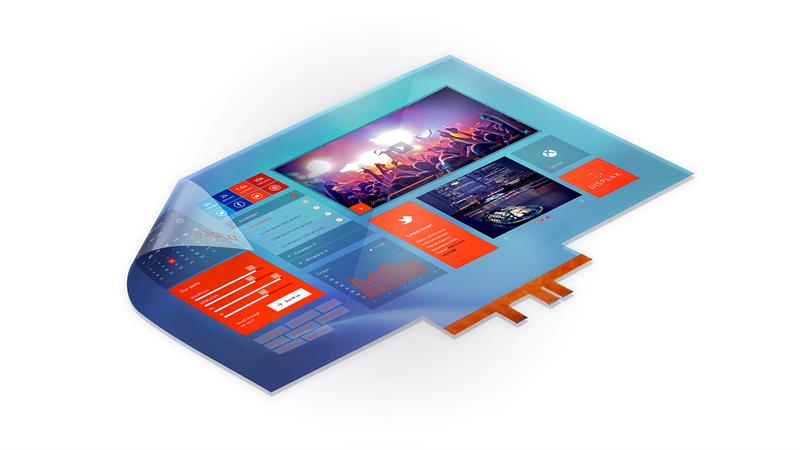What options do you have if you want to add a touch interface to a large area or if your application doesn’t use a screen for an interface? According to Crystal Display Systems (CDS), the answer could be projected capacitance touchscreen foils.
Tony Large, technical director, said: “These laminated foils can be attached to any surface – it could be a shop window, but it could also be a table.”
And the interesting thing is that these foils can be mounted to the surface in question using just soap, water and a squeegee.
“It’s a flexible approach to the problem of adding a touch interface,” Large explained. “It can be used on a range of surfaces; for example, there are some applications where the foil is used in conjunction with a projection system. An image is projected from overhead onto a table which has been fitted with a touchscreen foil on its underside.”
The touchscreen foils available through CDS are manufactured in Portugal by Displax, which claims to be a leader in large format multitouch technology. “Because Displax foils are made in Portugal,” said Large, “customers can get samples and products quickly.”
Displax foils come rolled up ready for use. Large cautioned: “Because it’s thin, you do have to be careful to make sure it doesn’t get creased during application.”
There’s a range of Displax touchfoils. The top of the range Ultra variant caters for touchpanels ranging from 30 to 105in diagonal. “But it is possible to make smaller versions – perhaps 20in – for some projects,” Large offered.
The foils have a set number of contact wires, so the larger the touchpanel, the larger the ‘pinch distance’ – the minimum distance at which the touchfoil’s controller can detect two discrete touches.

Displax Ultra Fit can detect up to 40 simultaneous touchpoints, with a 47in version able to detect touches as close as 24mm.
Once applied to the surface, the touchfoil links to the host computer via flexible tabs and a USB cable. “It’s HID compliant,” Large added.
Skin Ultra uses a high resolution conductive grid that can detect up to 100 simultaneous rapidly moving inputs. When used with Displax’ enhanced touch algorithms, the result is said to be a ‘superior touch experience’, with a response time to each touch of 5ms.
The touch sensor array is optimised for a 16:9 aspect ratio and provides a uniform response to touches across the whole area. This optimisation, CDS contends, results in a more accurate and precise touch detection.
According to Displax, Skin Ultra is supplied ready to apply to glass substrates with a thickness of up to 10mm. It adds that a 47in diagonal version of the technology will detect touches as close together as 12mm.
Skin Ultra also supports pressure sensing and this can be used with object recognition. “Because it has a smaller pinch distance,” Large explained, “it can be used for object recognition. If you’re interacting with a number of objects, you can put different shaped tabs on the bottom of each – a square on one, a triangle on another, for example. When the object is tapped, the system can ‘see’ the shape and recognise that particular object.”
While the system can detect touches as close together as 12mm, it can also recognise palm touches. The user can then determine whether to ignore such touches as possible false actions or to accept them.
Ultra Fit is a slightly less complex touch foil. “It’s easier to produce,” Large explained. “Because it detects fewer touches, it’s less expensive. It offers similar multitouch performance to Ultra, detecting about 40 touchpoints, making it more suitable for single user applications.” This will detect touches 24mm apart on a 47in device.
Working on glass substrates of up to 15mm thick, Ultra Fit is available in standard sizes ranging from 20 to 105in diagonal, as well as in 16:9 and 4:3 formats. Custom versions – 21:9, for example – and ‘stretched’ panels can also be supplied.
An older version of the technology is Dualtouch. This has a slower response time of 18ms, but only detects what the developer calls ‘two true independent touches’. “It’s good for simple ‘point and press’ applications,” Large said.
Demand for touchfoils is coming from a range of sectors. “Retail is a big market,” Large noted, “because of the quality of the touchscreen. Shop windows are a big market because they can be made to be interactive. Gaming will also be a big market,” he added. “But end user experience is driving this sector and the devices are applicable anywhere people expect there to be a touchscreen.”
Although the touchfoils are supplied precalibrated to work with 4mm thick substrates, Large said an additional piece of software is available that allows parameters to be optimised for the application.
“They’re flexible,” Large concluded, “they can be used on any surface. I know of one application where the touchfoil was applied to a globe; that was an expensive job and forming the foils was challenging. But I’ve got one potential customer who is thinking about installing a touch interface on a floor.”













